Sarah Mary Chadwick Finds New Musical Strengths Using A Century-Old Pipe Organ

Sarah Mary Chadwick’s artistic output has been an ideal combination of quality and quantity. The New Zealander cranks out paintings and drawings at an impressive clip, hurrying the ideas onto the canvas before she can overthink them. The same goes for her music. Whether for her former band Batrider or her solo work, she whips together dozens of songs for each album, winnowing them down and chucking the less exciting material until she has something solid and cohesive to record and release.
She didn’t have such luxuries when she received a commission to write a suite of songs using only the 147-year-old pipe organ installed in Melbourne Town Hall in her current hometown of Melbourne, Australia. With only three months to complete the project, she didn’t allow herself to play around with the nearly infinite sonic combinations at her hands and feet with this massive instrument. She had to focus in and make every note and moment count.
What that yielded was The Queen Who Stole The Sky, a stunning collection, recorded live, that finds Chadwick leaning into the natural creak of her voice and the dynamic wails she can reach as a counterbalance to the stentorian sounds of the pipe organ. The tone of these 11 songs was naturally affected by the tone of the instrument as she dug deep into feelings of desperation she wrestled with following the deaths of her father and a close ex-boyfriend and, as she puts it in the press notes for this album, “the fact that I’m always waiting for life and it never arrives – it only ever leaves.”
Paste caught up with Chadwick over a Skype call to talk about working with this mighty instrument and what she needed to do to make it her own.
Paste: How did you have to adjust your vocal performance to reckon with the sound of the organ?
Sarah Mary Chadwick: With a guitar or a real piano, it responds to you. If you want it to be loud, you play it loudly. If you want it to be quiet, you play it quietly. If you want to play something quiet on an organ, you have to build a sound that was quiet so that your singing wasn’t drowned out by it. So the dynamic is built into the arrangement. Working around that, I made sure that my singing was audible and that I gave myself as much space as I could, so that I wasn’t dwarfed by it. To be honest, I’m generally pretty confident about new projects but then when I first saw it, I didn’t know exactly how this was going to turn out. I was a little bit intimidated. But it worked out for me, I think.
And there are so many different sounds you can out of an instrument like that.
It feels almost infinite, really. You have any number of combinations. It’s been refurbished twice so it’s partially digitized so that you can save your settings. Once I built a song around a sound on each keyboard, then I could save those songs so if I wanted to rehearse something, I wasn’t have to build the sounds every time. That was really helpful.
Since this was a commissioned piece, did the city of Melbourne have to approve the songs in some manner or did they leave you alone?
I think if they weren’t happy with what I was doing, they would be very comfortable saying, “No, do something different.” Because I’ve heard people use that instrument in different capacities. I think that kind of instrument is what a lot of synthesizers are kind of based on, in terms of how you built sounds. So, I’ve heard people use it in a more synth-y capacity. But I disagree with that, so I tried to avoid getting into a situation where I was having to redo things. When I work, I try to keep whoever I’m working with up to date as I go to save myself time. I didn’t want to get into a position where it was two weeks before the recording and have them go, “Oh, we don’t like any of this.” I would have been fucked. So I made an effort to touch base as I was going to make sure they knew what to expect.
-

-

-

-

-

-

-

-

-

-

-

-

-

-

-

-

-

-

-

-

-

-

-

-

-

-

-

-

-

-

-

-

-

-

-

-

-

-

-

-








































